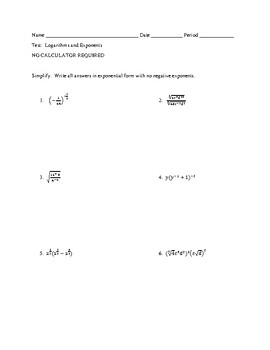Logarithms and Exponentials: Evaluate, Properties, Solving with Key
Fly by the Seat of My Pants Kind of Teacher
3 Followers
Grade Levels
10th - 12th, Higher Education
Subjects
Resource Type
Standards
CCSSHSN-RN.A.1
CCSSHSN-RN.A.2
CCSSHSA-SSE.B.3
CCSSHSA-SSE.B.3c
CCSSHSF-IF.C.8b
Formats Included
- PDF
Pages
3 pages
Fly by the Seat of My Pants Kind of Teacher
3 Followers
Description
This 20-question assignment could be used as a mini-review or a test. I use it as part of my testing (this is the non-calculator half of the test) before I begin graphing. It consists of:
- 6 simplify problems with exponential expressions, including rational and negative exponents
- 4 evaluate problems with logarithms, including the natural log
- 2 condense problems (use properties of logs to write as a single logarithm)
- 2 expand problems (use properties of logs to expand the expression)
- 6 solve problems (exponential and logarithmic equations)
- 1 bonus equation
Total Pages
3 pages
Answer Key
Included
Teaching Duration
N/A
Last updated 7 months ago
Report this resource to TPT
Reported resources will be reviewed by our team. Report this resource to let us know if this resource violates TPT’s content guidelines.
Standards
to see state-specific standards (only available in the US).
CCSSHSN-RN.A.1
Explain how the definition of the meaning of rational exponents follows from extending the properties of integer exponents to those values, allowing for a notation for radicals in terms of rational exponents. For example, we define 5 to the 1/3 power to be the cube root of 5 because we want (5 to the 1/3 power)³ = 5 to the (1/3)(3) power to hold, so (5 to the 1/3 power)³ must equal 5.
CCSSHSN-RN.A.2
Rewrite expressions involving radicals and rational exponents using the properties of exponents.
CCSSHSA-SSE.B.3
Choose and produce an equivalent form of an expression to reveal and explain properties of the quantity represented by the expression.
CCSSHSA-SSE.B.3c
Use the properties of exponents to transform expressions for exponential functions. For example the expression 1.15 to the 𝘵 power can be rewritten as ((1.15 to the 1/12 power) to the 12𝘵 power) is approximately equal to (1.012 to the 12𝘵 power) to reveal the approximate equivalent monthly interest rate if the annual rate is 15%.
CCSSHSF-IF.C.8b
Use the properties of exponents to interpret expressions for exponential functions. For example, identify percent rate of change in functions such as y = (1.02) to the 𝘵 power, 𝘺 = (0.97) to the 𝘵 power, 𝘺 = (1.01) to the 12𝘵 power, 𝘺 = (1.2) to the 𝘵/10 power, and classify them as representing exponential growth or decay.




